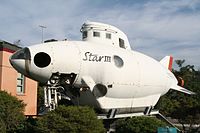Submersible: Difference between revisions
Reverting possible vandalism by Special:Contributions/207.63.202.189 to version by 82.115.54.254. False positive? report it. Thanks, User:ClueBot. (119730) (Bot) |
No edit summary |
||
| Line 6: | Line 6: | ||
[[Image:Underwater Flight.jpg|thumb|Experimental Sub dive in Monterey Bay. In a radical redesign of the submarine, it "flies" underwater like a plane rather than using ballast like a blimp. The designer thinks that a variation of this design can reach the bottom of the deepest trench in the ocean.]] |
[[Image:Underwater Flight.jpg|thumb|Experimental Sub dive in Monterey Bay. In a radical redesign of the submarine, it "flies" underwater like a plane rather than using ballast like a blimp. The designer thinks that a variation of this design can reach the bottom of the deepest trench in the ocean.]] |
||
A '''submersible''' is a type of [[underwater]] |
A '''submersible''' is a type of [[underwater]] ass with limited mobility which is typically transported to its area of operation by a surface vessel or large submarine. Apart from size, the technical difference between a 'submersible' and a 'submarine' is that submersibles are not totally autonomous. They may rely on a support facility or vessel for charging of batteries, high pressure air, high pressure oxygen replenishment, or all of these. |
||
A submersible vessel has greater mobility, using [[propeller|propeller screws]] or [[pump-jet]]s, than [[submersible chamber]]s (diving chambers or [[diving bell]]s), which are suspended from a [[cable]] and [[winch]] operated from the [[diving support vessel]]. |
A submersible vessel has greater mobility, using [[propeller|propeller screws]] or [[pump-jet]]s, than [[submersible chamber]]s (diving chambers or [[diving bell]]s), which are suspended from a [[cable]] and [[winch]] operated from the [[diving support vessel]]. |
||
Revision as of 18:15, 22 January 2008
This article needs additional citations for verification. (June 2007) |




A submersible is a type of underwater ass with limited mobility which is typically transported to its area of operation by a surface vessel or large submarine. Apart from size, the technical difference between a 'submersible' and a 'submarine' is that submersibles are not totally autonomous. They may rely on a support facility or vessel for charging of batteries, high pressure air, high pressure oxygen replenishment, or all of these.
A submersible vessel has greater mobility, using propeller screws or pump-jets, than submersible chambers (diving chambers or diving bells), which are suspended from a cable and winch operated from the diving support vessel.
Operation
Submersibles differ from submarines in that submersibles typically have shorter range, and operate underwater almost exclusively, having little function at the surface. Many submersibles operate on a "tether" or "umbilical", remaining connected to a tender (a submarine, surface vessel or platform).
ROVs
Small unmanned submersibles called "marine remotely operated vehicles" or MROVs are widely used today to work in water too deep or too dangerous for divers.
Remotely operated vehicles (ROVs) repair offshore petroleum platforms and attach cables to sunken ships to hoist them. Such remotely operated vehicles are attached by a tether (a thick cable providing power and communications) to control center on a ship. Operators on the ship see video images sent back from the robot and may control its propellers and manipulator arm. The wreck of the Titanic was explored by such a vehicle, as well as by a manned vessel.
Among the most famous submersibles is the deep-submergence research vessel DSV Alvin.
